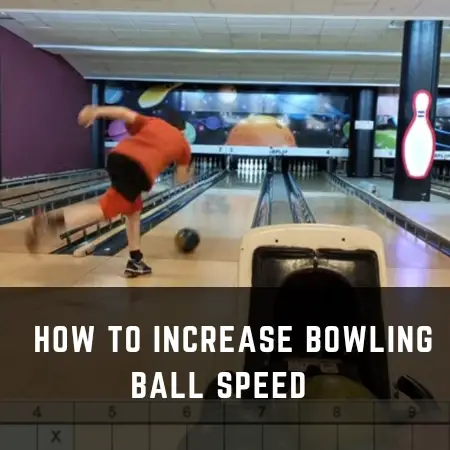
Do you seem to throw your bowling ball slow? Or does it hit the pins before you even turned around to balance yourself? Speed is one of the most-discussed topics in bowling, yet so many of you struggle with a slower ball speed. You probably lack momentum to hit the pins the way you intended to. Know this, more speed is equal to more momentum. So enhancing the speed of your bowling ball becomes essential when you specifically lack it. So today we are going to talk about increasing the ball speed and to know the most efficient ways to do that, you have to stay tuned. So read on, folks!
How to increase bowling speed?
Simply put, when you scoot back on the first three steps of your approach and gradually boost your speed during footwork, you build more momentum. This is the momentum that helps you increase your bowling ball speed. When it comes to increasing ball speed, I think it is easy for one to think we need to use our upper body and really try to muscle the ball down the lane to try to make it go faster. And my friends, that’s the most efficient way to do that.
To boost your ball speed, you have to use your legs instead of your upper body. Some of you might get the impression that if you throw the ball hard on the lane, that will add some speed. Well, it does, partially. But the biggest factor that contributed to your ball speed is the speed of your steps in your footwork. You have to generate more tempo and more energy go into the line and that way the energy can be transferred into more ball speed.
Whether you take a 5-step or a 4-step approach, the techniques and concepts are exactly the same. Speed is a product of how fast your feet are moving, not how fast your swing the ball with your shoulder. So what you need to do is stay right behind the dots and cover a larger distance with the same amount of steps. That way you have to use a faster tempo to make up for that distance. If you stand very close to that dotted line, it won’t help you much. So try backing off and move 6 to 12 inches back from where you typically stand.
Once you’re comfortable with your stance, you will see you now have a larger distance to cover. When you are increasing your tempo, you have to use sped-up steps to walk the longer distance you now have. Apart from your tempo, everything should be like before. When you take the first step, you prep yourself for the sped-up second, third, and fourth steps. As soon as you get to your third step, your brain will realize you have more distance to cover and that you are farther away from the foul line than you generally are, and this is probably when you will take a speedy fourth step.
It is important to ensure that you are not sprinting toward the foul line. You just have to make a conscious effort to enhance your tempo to generate more ball speed. By having your feet moving faster, your tempo being more in line, and better mechanics, you can successfully increase your ball speed. If you do everything right, the 15 or 16-pound weight will go with the momentum of your feet and will swing faster. If the ball swings faster with the faster footwork, your ball will definitely move faster down the lane.
To track your ball speed, you can use the Break Speed Radar from your bowling center and see if following these methods has increased the ball speed or not. I am confident you’ll see improvements.
Things to avoid when you’re increasing your bowling ball speed—
Avoid making any mistakes when you are learning how to boost your ball speed. What I see beginners do is they try to throw the ball as if they are angry at it and while doing that they lose their balance and all the built-up mechanics. As a result, the rev rate goes down and the ball just travels down the lane like crazy and hits all the wrong pins at all the wrong angles.
Under no circumstances increase the number of your steps. As mentioned earlier, keep everything nice and simple. Learn how to balance yourself so you don’t fall on the ground or slip too hard. And most importantly, don’t injure yourself when you are in your backswing phase. This is where the most mistakes are made by intermediate and beginner bowlers. I have seen a junior bowler dislocate his shoulder when he was attempting to throw the ball with a higher backswing. He overdid it, of course. So bowl carefully, and let those fasten footwork steps do the trick.
Conclusion
Did you know that the fastest bowling ball speed ever recorded in the history of ten-pin bowling is 34 miles per hour (55 km/h)? Now, I am not telling you to reach that, of course not! As the USBC suggests, if you keep your ball speed between 15 and 17.5mph, you will have an amazing ball reaction and rev rate. I like to believe this is the best speed for consistency with the newly-developed modern bowling balls. Naturally, they go faster than the ancient bowling balls. So increasing and then controlling its high speed is something you should definitely work on. I have put together some basic guidelines for you to help with your problem. The rest is yours to take care of. So go to your nearby bowling alley and get to practicing. Good luck and best wishes!

Passionate Bowler and Bowling Enthusiast
Jess Pinelli is a dedicated bowling enthusiast with a deep love for the sport that spans over 6 years. With numerous strikes, spares, and a few gutter balls under hes belt, he has honed his skills on lanes across the country. Pinelli’s journey in the world of bowling has been a remarkable one, from casual weekend games with friends to competitive league play and even a few local tournaments.
Driven by her passion for the game, Pinelli decided to channel her expertise and knowledge into the digital realm, becoming a prolific author on this bowling website. She’s your go-to source for everything bowling-related, from mastering the perfect hook to choosing the right bowling ball and even navigating the world of bowling etiquette.
When she’s not busy writing informative articles or reviewing the latest bowling gear, you’ll likely find Pinellis at her favorite local bowling alley, helping newcomers improve their game or enjoying some friendly competition with fellow bowlers. She firmly believes that bowling is not just a game but a community, and she’s committed to fostering that sense of camaraderie both online and offline.



